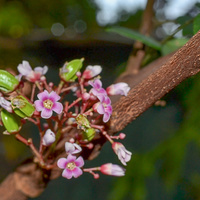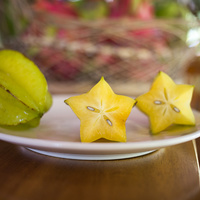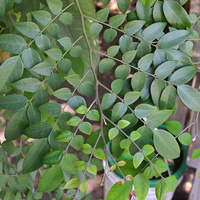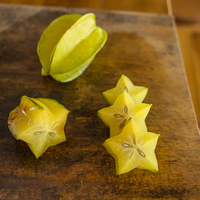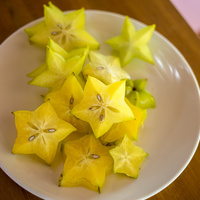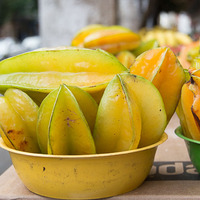Common name: Star fruit
Other common names: Carambola, Five corner
Description
Star fruit or Carambola is a cultivated fruit tree originating from humid tropical forests in Malaysia and Indonesia.
It is a small tree up to 10 m (33 ft) tall under ideal conditions, though is more typically 3 to 5 m (9 to 16 ft) with a slender trunk and low-branching habit, forming a dense, rounded or dome-shaped crown. The bark varies from grey to chocolate brown and from smooth to slightly cracked.
The leaves are large and compound, with up to thirteen glossy green, oval leaflets arranged in pairs along the length and with an extra leaflet at the tip.
The flowers are small with pink to lavender petals, borne in clusters arising on the branches and trunk, where they bloom steadily throughout the year.
Fertilised flowers develop into curious oval fruit with five prominent wings that, when cut cross-wise, reveal a star shape. Green-skinned when young, they become yellow-green to yellow-orange when ripe, depending on the variety and are typically 7 to 12 cm (2.7 to 4.7 in) long. Some have flat brown seeds at the centre, and some do not. The yellow-orange varieties tend to be larger and sweeter than those that are yellow-green.
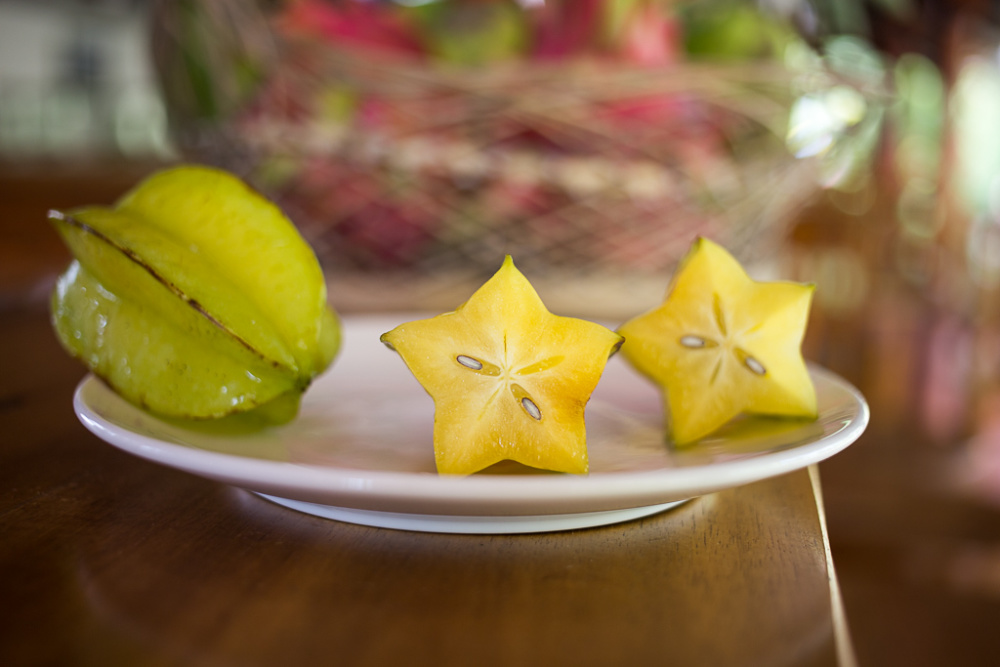
Star fruit cut in half
Use
The fruit are eaten fresh out-of-hand or are cut into star-shaped slices for use as a decorative garnish. The skin is thin, glossy and usually left on to be eaten with the pulp, which is firm, juicy, refreshing and varies in taste from sour to mildly sweet or sometimes bland, depending on the variety and growing conditions. They are also suitable for processing into dried fruit and are commonly stewed with sugar and cloves in its native range or are juiced to make a refreshing beverage.
The acidic juice has tarnish and stain removal properties and is used for cleaning metal surfaces as well as removing stains from white cloth.
Health use
The fruit pulp and juice contain good amounts of Vitamins A, B1 (Thiamine), B2 (Riboflavin), B3 (Niacin) and C (Ascorbic acid).
Climate
Star fruit grows naturally in humid subtropical and tropical climates, generally in frost-free areas with annual lows of 14 to 25°C, annual highs of 24 to 35°C, annual rainfall of 1200 to 4500 mm and a dry season of 5 months or less, extending to 12 months with irrigation or groundwater. However, the most flavoursome fruit tends to come from warm tropical lowland climates.
Growing
New plants are usually created by grafting selected cultivars onto seedling rootstock. This is the preferred method because seed-raised plants do not always come true to type, often resulting in trees with inferior fruit.
Performs best on free-draining clay and loam soils of a moderately acid to neutral nature, generally with a pH of 5.0 to 7.5, and on sites with partial sun or light shade exposure, especially in warm, low humidity environments. It has good tolerance to seasonal flooding.
The fruit of old cultivars or types are small and sour and have been replaced with new cultivars which are larger and more flavoursome. It is a heavy bearer, with reports of some exceptional trees bearing up to 440 pounds (200 kg) of fruit per year.
In the cooler parts of its climate range, Star fruit plants benefit from being planted close to a sun-facing wall, so that the wall will radiate heat, especially over the coolest days and nights. Without enough warmth, the plant may fail to flower and fruit, produce tasteless fruit, or become diseased and die.
Problem features
It is recorded as having escaped cultivation somewhere in the world, but there does not appear to be any record of it anywhere as a serious weed. It is assessed as a low weed risk species for Hawaii and Florida, respectively by the Hawaii Pacific Weed Risk Assessment (HPWRA) project and the IFAS Assessment of Non-Native Plants in Florida's Natural Areas.
This fruit have a high oxalic acid content which may adversely affect kidney function in some.
Where it grows
References
Books
-
Adams, C. D. 1972, Flowering plants of Jamaica, University of the West Indies, Mona, Greater Kingston
-
Allen, B. M. 1967, Malayan fruits : an introduction to the cultivated species, Donald Moore Press, Singapore
-
Croat, T. B. 1978, Flora of Barro Colorado Island, Stanford University Press, Stanford, California
-
Elevitch, C. R & Wilkinson, K. M. 2000, Agroforestry Guides for Pacific Islands, 1st ed., Permanent Agriculture Resources, Holualoa, Hawaii
-
Francis, J. K. and Liogier, H. A. 1991, Naturalized exotic tree species in Puerto Rico, General technical report SO-82, USDA Forest Service, Southern Forest Experiment Station, New Orleans
-
Janick, J., & Paull, R. E. 2008, The encyclopedia of fruit & nuts, CABI Publishing, Wallingford, Oxfordshire
-
Jensen, M. 1999, Trees commonly cultivated in Southeast Asia : an illustrated field guide, 2nd ed., Food and Agricultural Organisation of the United Nations (FAO) Regional Office for Asia and the Pacific (RAP), Bangkok
-
Kennard, W. C. & Winters, H. F. 1960, Some fruits and nuts for the tropics, Miscellaneous Publication No. 801, U.S. Department of Agriculture, Federal Experimental Station, Mayaguez, Puerto Rico
-
Krishen, P. 2006, Trees of Delhi : a field guide, Dorling Kindersley Publishers, Delhi
-
Leech, M. 2013, Bee Friendly: A planting guide for European honeybees and Australian native pollinators, Rural Industries Research and Development Corporation (RIRDC), Canberra, Australian Capital Territory
-
Macmillan, H. F. 1943, Tropical planting and gardening : with special reference to Ceylon, 5th ed, Macmillan Publishing, London
-
Morton, J. F. & Dowling, C. F. 1987, Fruits of warm climates, Creative Resources Systems, Winterville, North Carolina
-
Norrington, L. & Campbell, C. 2001, Tropical food gardens : a guide to growing fruit, herbs and vegetables in tropical and sub-tropical climates, Bloomings Books, Hawthorn, Victoria
-
Parrotta, J. A. 2001, Healing plants of peninsular India, CABI Publishing, Wallingford, Oxfordshire
-
Queensland Department of Primary Industries and Fisheries (QLD DPI) 2008, Queensland tropical fruit : the healthy flavours of North Queensland, Brisbane
-
Roecklein, J. C & Leung, P.S. 1987, A Profile of economic plants, Transaction Books, New Brunswick, New Jersey
-
Van Wyk, B. E. 2005, Food plants of the world: an illustrated guide, 1st ed., Timber Press, Portland, Oregon
-
Wenkam, N.S. 1983 to 1990, Foods of Hawaii and the Pacific Basin (5 volumes), College of Tropical Agriculture and Human Resources, University of Hawaii, Honolulu
Articles, Journals, Reports and Working Papers
-
Morton, J.F. 1964, Honeybee Plants of South Florida, Proceedings of the Florida State Horticultural Society, Vol 77:415-436.
-
Percival, S. & Findley, B. 2007 (Reviewed April 2014), What's in Your Tropical Fruit?, Fact Sheet HN 0708, University of Florida IFAS Extension Service, Gainesville, Florida
-
Watson, B.J., & Moncur, M. 1985, Guideline criteria for determining survival, commercial and best mean minimum July temperatures for various tropical fruit in Australia (Southern Hemisphere), Department of Primary Industries Queensland (DPI QLD), Wet Tropics Regional Publication, Queensland
-
Wenkam N.S. & Miller C.D. 1965, Composition of Hawaii fruits (Bulletin 135), University of Hawaii, Honolulu
